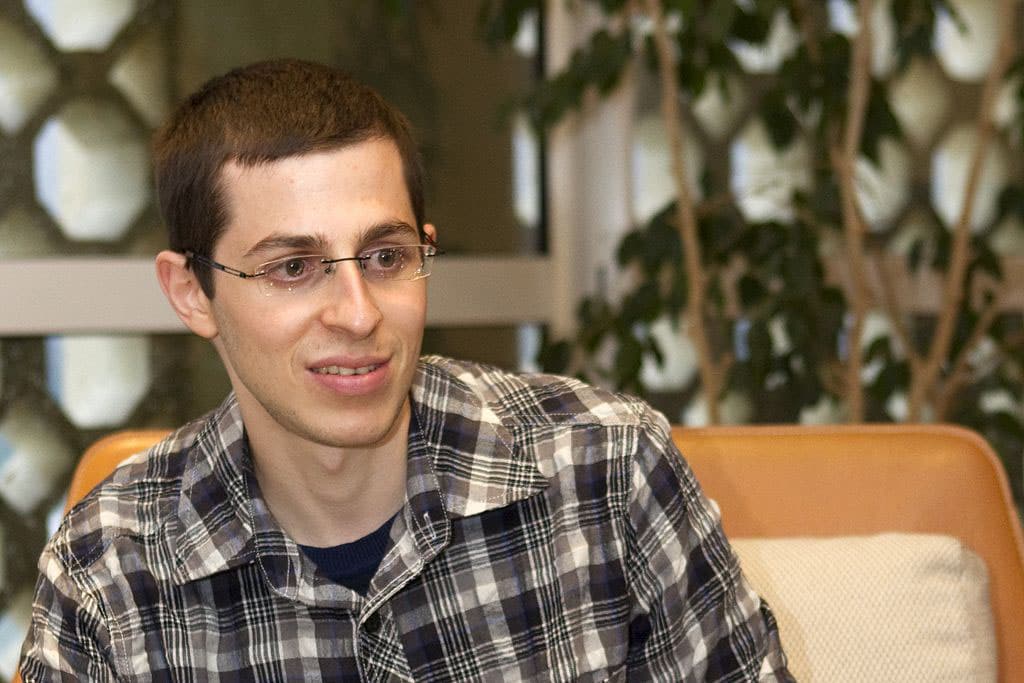 Gilad Shalit meets with French Ambassador to Israel Christophe Bigot (unseen) at the French embassy January 11, 2012 in Tel Aviv, Israel. (Photo Jack Guez-Pool/Getty Images)
Gilad Shalit meets with French Ambassador to Israel Christophe Bigot (unseen) at the French embassy January 11, 2012 in Tel Aviv, Israel. (Photo Jack Guez-Pool/Getty Images) In 2006, a 19-year-old IDF soldier named Gilad Shalit was abducted by Hamas in southern Israel and held in captivity in Gaza for five long years. In that time, he became “Israel’s son”; not a day went by that the Israeli public didn’t remind its leaders to bring Shalit home safely. In 2011, his family members even chained themselves in protest outside the Jerusalem residence of then-Prime Minister Bibi Netanyahu, and thousands of Jews around the world rallied for his release. As for me, I did what I always do when a life is in peril: I prayed.
My prayers on Shalit’s behalf were both short and long term: I entreated God to release him back into the arms of his mother, Aviva, and his father, Noam, as soon as possible. And, for some reason, I asked that he be able to live to see his wedding day. Perhaps I figured that his wedding day, which would undoubtedly be the happiest day of his life, offered the starkest contrast between the suffering he was enduring in the clutches of Hamas.
Two weeks ago, on June 23, Shalit married his fiancé, Nitzan Shabbat, in a small ceremony in central Israel. As I watched a short video of a beaming Shalit standing beneath the chuppah, I couldn’t help but think about the unforgettable image of a frail, pale, and seemingly broken young man on the day he returned home ten years ago on October 18, 2021. Humble and humbled, appearing ever so small, he saluted Netanyahu in a way that left no doubt that he had served his country.
Two weeks ago, on June 23, Shalit married his fiancé, Nitzan Shabbat, in a small ceremony in central Israel.
To the naked eye, Shalit looked like any happy groom on his wedding day, but if you look closely at the pictures, you’ll see that his doe-like, gentle eyes betray a secret: his family, close friends, and his bride might be privy to his pain, but only he knows how much he suffered during those five years in Gaza.
And if you survived five years in Hamas captivity, your wedding doesn’t merely celebrate love; it builds an altar to life, survival and, ultimately, continuity.
But not all abducted IDF soldiers receive a second chance. Ehud “Udi” Goldwasser, z’l, was never able to return home to his wife of just ten months, Karnit, after he was captured by Hezbollah in July 2006. His family endured the torment of the unknown for what seemed like an eternity, until finally, two years after he was abducted, they learned he had been killed.
His family endured the torment of the unknown for what seemed like an eternity, until finally, two years after he was abducted, they learned he had been killed.
Eldad Regev, z’l, never even had a chance to stand beneath the chuppah. He was captured along with Goldwasser, sparking the Second Lebanon War between Israel and Hezbollah. Both their bodies were returned to Israel during a prisoner exchange with Hezbollah in 2008.
As for Shalit, his freedom came at an enormous cost: Israel released 1,027 Palestinian prisoners, many of them serving life sentences (Hamas leader Ahmed Jabari told the Saudi Arabian newspaper Al-Hayat that the prisoners collectively killed 569 Israelis). Shalit became the first IDF soldier to return home alive in 26 years. It was the highest price the Jewish state had ever paid for one soldier.
A few days after Shalit’s release, Daniel Bar Tal, a political psychology professor at Tel Aviv University, told The Jerusalem Post:
“Here we see the basic dilemmas between the individual and the collective, and we see victim pitted against victim. Gilad Shalit is a victim who was violently kidnapped, in a way that Israelis do not consider to be a normative means of struggle. Therefore, one side says, he should be returned at any price. But the families of those killed in terrorist attacks and the people who were wounded in those attacks are victims, too, and they say that no price should be paid to the murderers. And it is truly a dilemma, because no side is right, and no side is wrong.”
In the coming years, there will hopefully be other happy stories about Gilad Shalit: news of Gilad and Nitzan’s first child (and subsequent children); the release of his book (if he ever writes one); and, one day, perhaps in about 19 or 20 years, news that his first born, whether male or female, has reported for duty to the IDF.
Judaism teaches that the moments during which a bride and groom stand beneath a chuppah constitute a particularly auspicious time for prayer, and that on their wedding day, a couple possesses the power to offer brachot, or blessings, to others.
There are many in Israel whose loved ones were savagely murdered by those now-released prisoners. Perhaps they were understandably not celebrating as enthusiastically as other Israelis the day Shalit was released ten years ago. I’ll never know what was going through Shalit’s mind as he stood under the chuppah, but I can only hope that he whispered a prayer of healing and protection for all Israelis, whether those whose hearts are full … or still broken.
Tabby Refael is a Los Angeles-based writer, speaker and civic action activist. Follow her on Twitter @RefaelTabby.























 More news and opinions than at a Shabbat dinner, right in your inbox.
More news and opinions than at a Shabbat dinner, right in your inbox.